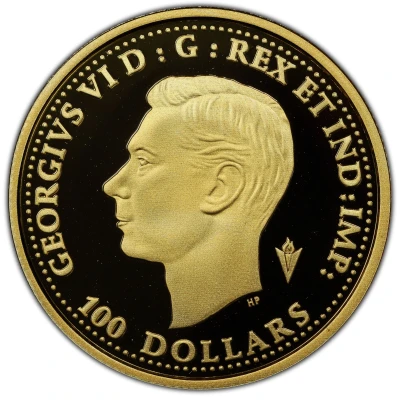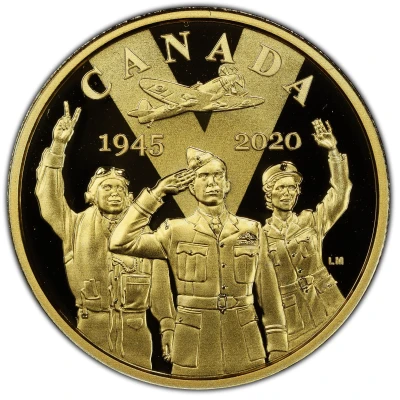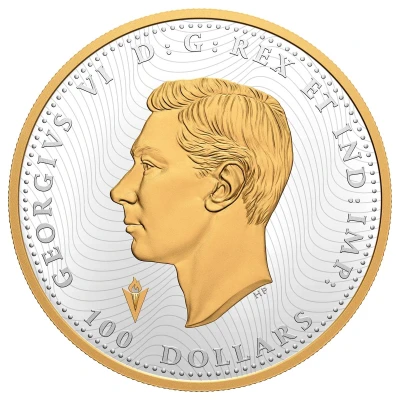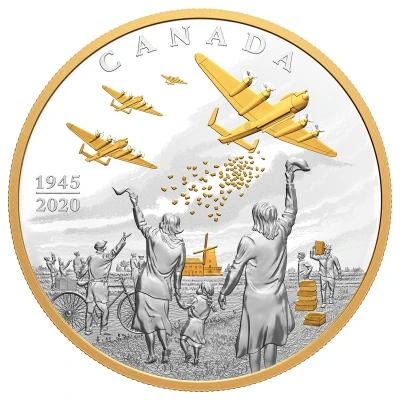100 Dollars - Elizabeth II Armorial Bearings of the Dominion of Canada
2020 year| Silver (.9999) (Selective gold plating) | 311.54 g | 76.25 mm |
| Issuer | Canada |
|---|---|
| Queen | Elizabeth II (1952-2022) |
| Type | Non-circulating coin |
| Year | 2020 |
| Value | 100 Dollars 100 CAD = USD 74 |
| Currency | Dollar (1858-date) |
| Composition | Silver (.9999) (Selective gold plating) |
| Weight | 311.54 g |
| Diameter | 76.25 mm |
| Shape | Round |
| Technique | Milled |
| Orientation | Medal alignment ↑↑ |
| Updated | 2024-10-03 |
| Numista | N#354722 |
|---|---|
| Rarity index | 100% |
Reverse
The reverse design features the armorial bearings of the Dominion of Canada (1868-1921). It is based on the original 1868 pen and ink drawing by Sir Charles GeorgeYoung and includes the changes requested by the Duke of Buckingham. Granted by Royal Warrant of Queen Victoria, the Dominion shield features the quartered arms of the first four provinces to join Confederation: Ontario (the cross of St. George and a sprig of three maple leaves), Quebec (two fleurs-de-lis, a lion passant guardant and a sprig of three maple leaves), Nova Scotia (a salmon between three thistles) and New Brunswick (a lion passant guardant and an ancient galley).
Designer: Sir Charles George Young
Edge
Serrated
Comment
A stunning piece of heraldic art that represented a young Canada.Dated May 26, 1868, a royal warrant of Her Majesty Queen Victoria granted individual arms to the first four provinces of the newly formed Dominion of Canada: Ontario, Quebec, Nova Scotia and New Brunswick. It further stated that these provincial arms were to be quartered for use as a Great Seal for the new country. While the quartered arms were never used for the Great Seal of Canada, the four-province shield was adopted as the heraldic emblem of the Dominion of Canada. It appeared on the flag of the Governor General of Canada, as well as the Canadian Blue Ensign and the Canadian Red Ensign flown at sea. As more provinces joined Confederation, emblematic devices continued to be (informally) added to the Dominion shield until 1921, when it was replaced with the duly authorized Arms of Canada.
"Although it did not serve its intended purpose, the four-province emblem became widely recognized as the national coat of arms and was included in the flag of the Governor General and the Canadian Blue Ensign in 1870, in the Canadian Red ensign in 1892, and on $5 and $10 coins minted in Ottawa from 1912 to 1914."
Auguste Vachon: Outaouais Herald of Arms Emeritus, Member of the International Academy of Heraldry.
"My background in History taught me to search the archives for content, but this was the first time I got to handle such important historical documents. I'm so glad they gave me white gloves to handle them—the weight of seeing these treasures in person made my hands sweat! Reading the correspondence to Duke of Buckingham, with its perfect calligraphy, made me nervous in the best of ways. I was so excited to handle these precious documents dating back to 1868." Jamie Desrochers, Royal Canadian Mint
Did you know…
Sir Charles George Young's vision for the arms of Ontario consisted of the cross of St. George and a wheat sheaf, but the design was revised to include the sprig of maple leaves featured on this coin.
The original proposal for the arms of New Brunswick included a horse that symbolized the House of Brunswick, but it was replaced with the lion of England seen on this coin.
Nova Scotia had already been granted armorial bearings in 1625 but was assigned new arms after joining Confederation (those arms appear on this coin). The original armorial bearings were restored in 1929.
This shield was granted to decorate the Great Seal of Canada. But when the engraved version arrived in Canada in 1870, its design was completely different. The provincial shields were included, but they appeared as individual shields attached to oak trees on either side of the seated figure of Queen Victoria.
Packaging:
Your coin is encapsulated and presented in a Royal Canadian Mint-branded clamshell with a black beauty box.
Interesting fact
One interesting fact about this coin is that it features a unique combination of silver and gold plating. The coin is made of .9999 silver, but it also has selective gold plating on certain design elements, such as the maple leaves and the crown. This creates a striking contrast between the silver and gold parts of the coin, making it a visually stunning piece.
Price
| Date | Mintage | VG | F | VF | XF | AU | UNC |
|---|---|---|---|---|---|---|---|
| 2020 | 800 | - | - | - | - | - | - |
Values in the table are based on evaluations by sales realized on Internet platforms. They serve as an indication only for 100 Dollars - Elizabeth II (Armorial Bearings of the Dominion of Canada) 2020 coin.



